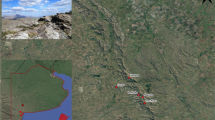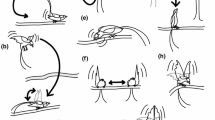Abstract
Annual killifish have an annual life cycle unique among vertebrates. Adults lay desiccation-resistant eggs in the soil of the temporary pools they inhabit. Courtship behavior of some Neotropical killifish consists of a series of displays performed by males and females that ends in the total or partial burial of the couple. However, little information exists on their reproductive isolation mechanisms, including a detailed analysis of courtship signals. In this study, we analyzed the courtship behavior of a Neotropical annual killifish (Austrolebias nigripinnis) within a comparative frame. The most frequent units in males were lateral (44%) and sigmoid displays (26%), where males exhibit morphological and color patterns to females. Females showed a high frequency (44%) of quiescence, suggesting that this unit may have an evaluative role during courtship. Behavioral units recognized in this species show some differences with other related species (i.e., Austrolebias affinis), mainly in frequency and duration, but also in sequence. Although the results of this work cannot determine if these differences constitute reproductive isolation mechanisms, it provides fundamental elements to try to establish kinship relationships and solve the complexity implicit in the definition of species.


Similar content being viewed by others
Data availability
Data will be shared upon request to the authors.
References
Barlow GW (2002) How behavioral studies contribute to the species problem: a piscine perspective. Fish Fish 3:197–212
Belote DF, Costa WJEM (2002) Reproductive behavior patterns in the neotropical annual fish genus Sympsonichthys Carvalho, 1959 (Cyprinodontiformes, Rivulidae): description and phylogenetic implications. Bol Mus Nac NS RJ 489:1–10
Belote DF, Costa WJEM (2003) Reproductive behavior of the Brazilian annual fish Cynolebias albipunctatus COSTA & BRASIL, 1991 (TELEOSTEI, CYPRINODONTIFORMES, RIVULIDAE): a new report of sound production in fishes. ArqMus Nac RJ 61:241–244
Belote DF, Costa WJEM (2004) Reproductive behavior patterns in three species of the South American annual fish genus Austrolebias Costa, 1998 (Cyprinodontiformes, Rivulidae). Bol Mus Nac NS RJ 514:1–7
Berois N, Arezo MJ, Papa NG, Clivio GA (2012) Annual fish: developmental adaptations for an extreme environment. Wires Dev Biol 1:595–602
Butlin R, Ritchie M (1994) Behavior and speciation. In: Slater PJ, Halliday TR (eds) Behavior and Evolution. Cambridge University Press, Cambridge, pp 43–79
Costa WJEM (2001) The neotropical annual fish genus Cynolebias (Cyprinodontiformes: Rivulidae): phylogenetic relationships, taxonomic revision and biogeography. Ichthyol Explor Freshw 12(4):333–383
Costa WEJM (2006) The South American annual killifish genus Austrolebias (Teleostei: Cyprinodontiformes: Rivulidae): phylogenetic relationships, descriptive morphology and taxonomic revision. Zootaxa 1213:1–162
Costa WJEM (2009) Morphology of the teleost pharyngeal jaw apparatus in the neotropical annual killifish genus Cynolebias (Cyprinodontiformes: Aplocheiloidei: Rivulidae). Cybium 33(2):145–150
Costa WJEM, Ramos T, Alexandre LC, Ramos RT (2010) Cynolebias parnaibensis, a new seasonal killifish from the Caatinga, Parnaíba River basin, northeastern Brazil, with notes on sound producing courtship behavior (Cyprinodontiformes: Rivulidae). Neotrop Ichthyol 8:283–288
Darwin C (1872) The origin of species by means of natural selection. 6th ed. -London: John Murray
Eberhard WG (1996) Females control: sexual selection by cryptic female choice. Monographs in behavior and ecology. Princeton University Press, Princeton
Errea A, Danulat E (2001) Growth of the annual fish, Cynolebias viarius (Cyprinodontiformes), in the natural habitat compared to laboratory conditions. Environ Biol Fishes 61:261–268
García D (2013) Señales de cortejo como caracteres filogenéticos en peces anuales Tesis de Maestría. PEDECIBA, Universidad de la República, Montevideo. https://doi.org/10.13140/RG.2.2.10853.45280
García D, Loureiro M, Tassino B (2008) Reproductive behavior in the annual fish Austrolebias reicherti Loureiro & García 2004 (Cyprinodontiformes: Rivulidae). Neotrop Icthyol 6(2):243–248
García D, Smith C, Machín E, Loureiro M, Reichard M (2019) Changing patterns of growth in a changing planet: how a shift in phenology affects critical life-history traits in annual fishes. Freshw Biol 64(10):1848–1858
García G, Lalanne AI, Aguirre G, Capetta M (2001) Chromosome evolution in the annual killifish genus Cynolebias and mitochondrial phylogenetic analysis. Chromosome Res 9:437–448
Gittleman JL, DM Decker (1994) The phylogeny of behavior. En: Behavior and Evolution. Slater PJB, Halliday TR (eds) Cambridge University Press 80–104
Gregorio O, Berdan EL, Kozak GM, Fuller RC (2012) Reinforcement of male mate preferences in sympatric killifish species Lucania goodei and Lucania parva. Behav Ecol Sociobio 66(10):1429–1436
Hankinson SJ, Morris MR (2003) Avoiding a compromise between sexual selection and species recognition: female swordtail fish assess multiple species-specific cues. Behav Ecol 14(2):282–287
Higham JP, Hebets EA (2013) An introduction to multimodal communication. Behav Ecol Sociobio 67(9):1381–1388
Johnson PA, Gullberg U (1998) Theory and models of sympatric speciation. En Endless forms. Species and speciation. Howard D J, Berlocher SH (eds) Oxford University Press, New York
Johnstone RA (1996) Multiple displays in animal communication: “backup signals” and “multiple missages.” Phil Trans R Soc Lond B 351:329–338
Lorenz K (1958) The evolution of behavior. Sci Am 199:67–78
Loureiro M (2004) Sistemática y biogeografía de los peces anuales de la subtribu Cynolebiatina (Cyprinodontiformes: Rivulidae, Cynolebiatinae). Tesis de Doctorado. PEDECIBA. Universidad de la República, Montevideo
Loureiro M, Bessonart J (2017) The IUCN red list of threatened species. Austrolebiasviarius. Endangered Species of annual fish from Uruguay. UICN. https://doi.org/10.2305/IUCN.UK.2017-.RLTS.T187245A1825294
Loureiro M, de Sá R, Serra SW, Alonso F, Lanés LEK, Volcan MV, García G (2018) Review of the family Rivulidae (Cyprinodontiformes, Aplocheiloidei) and a molecular and morphological phylogeny of the annual fish genus Austrolebias Costa 1998. Neotrop Ichthyol 16(3):1–20
Loureiro M, Duarte A, Zarucki M (2011) A new species of Austrolebias Costa (Cyprinodontiformes: Rivulidae) from northeastern Uruguay, with comments on distribution patterns. Neotrop Ichthyol 9(2):335–342
McLennan DA, Ryan MJ (1999) Interspecific recognition and discrimination based upon olfactory cues in northern Swordtails. Evolution 53(3):880–888
Miller CW, Svensson EI (2014) Sexual selection in complex environments. Annu Rev Entomol 59:427–445
Passos C, Reyes F, Tassino B, Rosenthal GG, Gonzalez A (2013) Female annual killifish Austrolebias reicherti (Cyprinodontiformes, Rivulidae) attend to male chemical cues. Ethology 119(10):891–897
Passos C, Tassino B, Loureiro M, Rosenthal G (2015) Intra- and intersexual selection on male body size in the annual killifish Austrolebias charrua. Behav Process 96:20–26
Pavey SA, Collin H, Nosil P, Rogers SM (2010) The role of gene expression in ecological speciation. Ann N Y Acad Sci 1206(1):110–129
Rafferty NE, Boughman JW (2006) Olfactory mate recognition in a sympatric species pair of three-spined sticklabacks. Behav Ecol 17(6):965–970
Regan CT (1912) A revision of the poeciliid fishes of the genera Rivulus, Pterolebias, and Cynolebias. Ann Mag Nat Hist 10(59):494–508
Reis R, Lima F (2009) Austrolebias affinis. The IUCN Red List of Threatened Species 2009: e.T167765A6378899. https://doi.org/10.2305/IUCN.UK.2009-2.RLTS.T167765A6378899.en. www.iucnredlist.org. Accessed 17 July 2023
Reyes F, Tassino B, Passos C (2018) Females of the annual killifish Austrolebias reicherti (Cyprinodontiformes: Rivulidae) recognize conspecific mates based upon chemical cues. Behav Process 155:33–37
Ridley M (2004) Evolution. Malden, Blackwell Publishing. Pal Arch’s J Verteb Paleontol 5(1):01–01
Rosenthal GG, Ryan MJ (2022) Sexual selection and the ascent of women: mate choice research since Darwin. Science 375(6578):eabi6308
Schluter D (1998) Ecological causes of speciation. En Endless forms. Species and speciation. Howard DJ, Berlocher SH (eds) Oxford University Press, New York 114–129
Scholes E III (2008) Evolution of the courtship phenotype in the bird of paradise genus Parotia (Aves: Paradisaeidae): homology, phylogeny, and modularity. Biol J Linn Soc 94(3):491–504
Selz OM, Pierotti ME, Maan ME, Schmid C, Seehausen O (2014) Female preference for male color is necessary and sufficient for assortative mating in 2 cichlid sister species. Behav Ecol 25(3):612–626
Simpson BRC (1979) The phenology of annual killifishes. Symp Zool Soc Lond 44:243–261
Trivers RL (1972) Parental investment and sexual selection. In: Campbell B (ed) Sexual selection and the descent of man, 1871–1971. Aldine. Routledge, Chicago, pp 136–179
Vari RP, Malabarba LR (1998) Neotropical ichtyology: and overview. En Phylogeny and classification of Neotropical Fishes. Malalabarba LR, Reis RE, Vari RP, Lucena ZM, Lucena CAS (eds), pp. 1–11. Porto Alegre: EDUPUCRS
Vaz-Ferreira R, Sierra B (1973) Caracteres etológicos, genéricos y específicos en los peces del género CynolebiasSteindachner, 1876. Bol Soc Zool Uruguay 2:22–35
Vrtílek M, Žák J, Pšenička M, Reichard M (2018) Extremely rapid maturation of a wild African annual fish. Curr Biol 28:R822–R824
Wignall AE, Herberstein ME (2022) Male courtship reduces the risk of female aggression in web-building spiders but varies in structure. Behav Ecol 33(1):280–287
Winker K (2021) An overview of speciation and species limits in birds. Ornithology 138(2):1–27
Wong BBM, Fisher HS, Rosenthal GG (2005) Species recognition by male swordtails via chemical cues. Behav Ecol 16(4):818–822
Wourms JP (1972a) The developmental biology of annual fishes. I. Stages in the normal development of Austrfundulus myersi. J Exp Zool 182:143–168
Wourms JP (1972b) The developmental biology of annual fishes. II. Naturally ocurring dispersion and reaggregation of blastomeres during the development of annual fish eggs. J Exp Zool 182:169–200
Acknowledgements
We would like to thank the two anonymous referees who helped to improve very much previous versions of the manuscript. To Juan Barreneche, Sebastián Serra, and Alejandro Duarte for their help in field sampling. The Ethology Section of the University provided the space and technology for experiments. DL and ML belong to Sistema Nacional de Investigadores (SNI-ANII).
Author information
Authors and Affiliations
Corresponding author
Ethics declarations
Ethics approval
All ethical guidelines were followed and the experimentation protocol was approved by the ethics committee of the University under the number 240012-000025-22.
Conflict of interest
The authors declare no competing interests.
Additional information
Publisher's Note
Springer Nature remains neutral with regard to jurisdictional claims in published maps and institutional affiliations.
Supplementary Information
Below is the link to the electronic supplementary material.
Supplementary file1 (MP4 43.1 MB)
Rights and permissions
Springer Nature or its licensor (e.g. a society or other partner) holds exclusive rights to this article under a publishing agreement with the author(s) or other rightsholder(s); author self-archiving of the accepted manuscript version of this article is solely governed by the terms of such publishing agreement and applicable law.
About this article
Cite this article
Segovia, J.C., Loureiro, M. & García, D. Reproductive behavior analysis in the annual killifish Austrolebias nigripinnis (Regan, 1912) (Cyprinodontiformes: Rivulidae). acta ethol 26, 239–246 (2023). https://doi.org/10.1007/s10211-023-00426-4
Received:
Revised:
Accepted:
Published:
Issue Date:
DOI: https://doi.org/10.1007/s10211-023-00426-4




